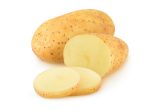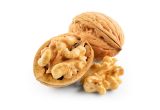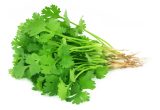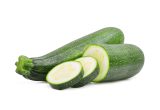Almond

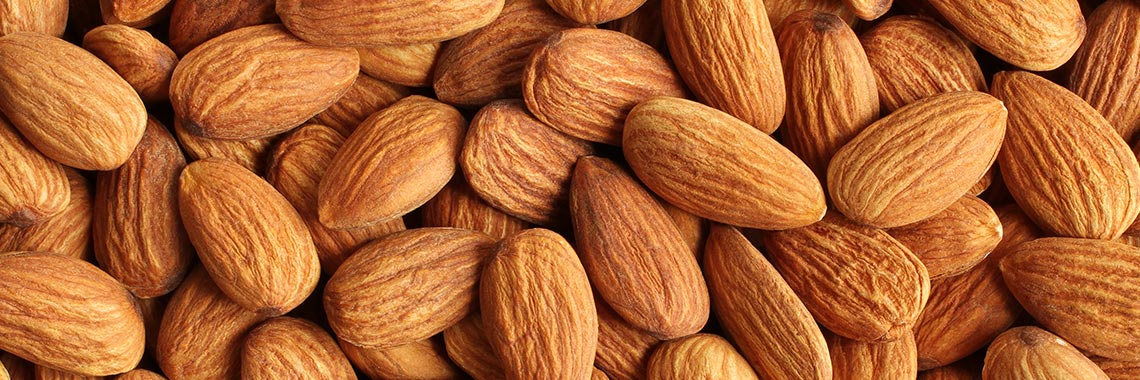
Description
- The almond tree (Prunus dulcis, Prunus amygdalus var. dulcis, Amygdalus communis) belongs to the Rosaceae family.
- The United States harvests more than half of the world’s almond production (FAO, 2018).
- The harvest of fresh (green) almonds takes place in September and October. Dry almonds are available all year round (Les fruits et légumes frais).
PHYSICAL AND ORGANOLEPTIC CHARACTERISTICS
- The bitterness of almonds depends on their amygdalin content. Amygdalin content varies from 2.16 to 157.44 mg/kg in sweet almonds and from 33 006.60 to 53 998.30 mg/kg in bitter almonds (Lee, 2013).
- When chewed, amygdalin breaks down into hydrogencyanide and benzaldehyde. While the latter is responsible for the “pure almond” aroma in synthetic oils and essences, hydrogencyanide, which is very present in bitter almonds, can be toxic to humans (King, 2019).
- The region in which the almond tree is grown may have an influence on the amygdalin concentration (Lee, 2013).
COMPOSITION CHARACTERISTICS (excluding macronutrients, vitamins and minerals)
- The fibres contained in the almond skin, in its natural state or after being bleached, seem to have properties identical to fructo-oligosaccharides, namely a prebiotic effect on the bacterial strains found in the gut flora (Mandalari, 2010). The cell walls of the almond contain pectic substances, rich in arabinose, which may be at the origin of this prebiotic effect (Mandalari, 2008).
- Almonds are an important source of polyphenols.
- Nine phenolic acids and nineteen flavonoids have been found in the whole almond. The main polyphenol is catechin, followed by chlorogenic acid and naringenin (Čolić, 2017).
- The skin of the almond also contains a significant amount of flavonoids, mainly flavan-3-ols and flavonols (Llorach, 2010).
- Consumption of 30 g of almonds per day appears to be associated with health benefits. It is reported to help prevent metabolic diseases (control of blood sugar in diabetics, hyperuricemia and hyperlipidemia), reduce risk factors for coronary heart disease and improve the profile of the gut microbiota (Diella, 2018).
- Furthermore, a study has shown that natural (NS) and bleached (BS) almond skin extracts may have an inhibitory effect on herpes simplex virus1 (HSV-1) replication. Quercetin, epicatechin and catechin (polyphenols of the flavonoid family) are reportedly able to block the production of HSV-1 infectious particles. This capacity appears to be greater in NS extracts than in BS extracts (Bisignano, 2017).
- Rich in unsaturated fatty acids, including oleic acid, linoleic acid and palmitic acid, almond oil may be a potential therapeutic agent for colon cancer due to its anticancer and anti-proliferative effects (Mericli, 2017). However, the lipid profile of the almond is influenced by the region in which the almond tree is grown and is also variable depending on the cultivar (Sathe, 2008).
- Almond cultivars also differ in their volatile profiles, in their non-volatile metabolites (pyranosides, peptides, amino acids, etc.) and in their profiles of tocopherols, derivatives of vitamin E (King, 2019).
DRY
The following values are approximate and depend on variety, season, ripeness, cultivation conditions, etc.
The energy content of almonds (with skin) is on average 600 kcal per 100 g, i.e. 2480 kJ. A 30 g serving of almonds (around 24 almonds) provides about 180 calories (kcal), or 744 kJ.
COMPOSITION TABLES
For each nutrient, these tables provide information on the content, minimum and maximum values per 100 g net of dry almonds (with skin), while the percentage of the Dietary Reference Values (DRVs) is calculated for a 30 g portion.
MACRONUTRIENTS
DRV% * :
For a portion of 30 g.
Constituent
(g)
Average content
per 100g
Min-Max
per 100g
Average content
per 30g
DRV% *
Water
4,80
3,2 - 12,40
1,44
-
Fibers
12,50
4,70 - 19,30
3,75
-
Carbohydrates
9,51
-
2,85
1,10
Sugars
4,20
3,60 - 5,20
1,26
1,40
Lipids
51,30
36 - 57,40
15,39
21,99
Saturated fat
4,11
3,13 - 4,73
1,23
6,17
Protein
22,60
3,90 - 30,70
6,78
13,56
Constituent
(g)
Amount
Min-Max
DRV%
Water
Ciqual 2020
-
-
Fibers
Ciqual 2020
-
-
Carbohydrates
Ciqual 2020
-
Règlement (UE) N°1169/2011 du parlement Européen et du conseil du 25 octobre 2011
Sugars
Ciqual 2020
-
Règlement (UE) N°1169/2011 du parlement Européen et du conseil du 25 octobre 2011
Lipids
Ciqual 2020
-
Règlement (UE) N°1169/2011 du parlement Européen et du conseil du 25 octobre 2011
Saturated fat
Ciqual 2020
-
Règlement (UE) N°1169/2011 du parlement Européen et du conseil du 25 octobre 2011
Protein
Ciqual 2020
-
Règlement (UE) N°1169/2011 du parlement Européen et du conseil du 25 octobre 2011
Zoom on carbohydrates
- The carbohydrate content is 2.85 g for a 30 g serving, i.e. 9.51 g per 100 g, which is below the average content of nuts: approximately 18.13 g per 100 g.
- These include sucrose (4 g per 100 g) and glucose (0.20 g per 100 g).
- Almonds are low in sugar* (4.20 g per 100 g) as they contain no more than 5 g per 100 g.
Zoom on fibres
- Almonds are source of fibre* as they contain more than 1.5 g of fibre per 100 kcal of fruit.
- For a typical almond serving of about 30 g, the amount of fibre is 3.75 g.
Zoom on protein
- The protein content (22.60 g per 100 g) is well above the average value for nuts (16.73 g per 100 g). After peanuts, almonds are the nuts with the highest protein content, according to the Ciqual 2020 table.
- For a 30 g serving, almonds contain 6.78 g of protein.
Zoom on lipids
- Almonds are above all an important source of lipids (51.30%) and more particularly of unsaturated fatty acids (44.90% of total lipids).
- Oleic acid, linoleic acid, palmitic acid and stearic acid represent respectively 33.30%, 10.50%, 3.16% and 0.87% of the total lipids present in almonds
- The fat content is below the average value for nuts (41.27 g per 100 g).
- For a 30 g serving of almonds, the amount of fat is 15.30 g.
*Regulation (EC) No 1924/2006 of the European Parliament and of the Council of 20 December 2006 on nutrition and health claims made on foods.
MINERALS AND TRACE ELEMENTS
| Constituent |
Average content
per 100g |
Min-Max per 100g |
Average content
per 30g |
DRV% * |
|---|---|---|---|---|
| Calcium (mg) | 260 | 198 - 373 | 78 | 9,75 |
| Chloride (mg) | - | - | - | - |
| Copper (mg) | 0,96 | 0,10 - 1,57 | 0,29 | 28,80 |
| Iron (mg) | 3,40 | 2,58 - 502 | 1,02 | 7,29 |
| Iodine (µg) | < 20 | 0,02 - NC | 6 | - |
| Magnesium (mg) | 270 | 224 - 303 | 81 | 21,60 |
| Manganese (mg) | 1,90 | 1,31 - 3,98 | 0,57 | 28,50 |
| Phosphorus (mg) | 510 | 364 - 569 | 153 | 21,86 |
| Potassium (mg) | 800 | 543 - 902 | 240 | 12 |
| Selenium (µg) | < 20 | 0,50 - NC | 6 | - |
| Sodium (mg) | < 5 | 0 - 11 | 1,50 | - |
| Zinc (mg) | 3,50 | 2,02 - 4,03 | 1,05 | 10,50 |
| Constituent | Amount | Min-Max | DRV% |
|---|---|---|---|
| Calcium (mg) | Ciqual 2020 | - | Règlement (UE) N°1169/2011 du parlement Européen et du conseil du 25 octobre 2011 |
| Chloride (mg) | Ciqual 2020 | - | Règlement (UE) N°1169/2011 du parlement Européen et du conseil du 25 octobre 2011 |
| Copper (mg) | Ciqual 2020 | - | Règlement (UE) N°1169/2011 du parlement Européen et du conseil du 25 octobre 2011 |
| Iron (mg) | Ciqual 2020 | - | Règlement (UE) N°1169/2011 du parlement Européen et du conseil du 25 octobre 2011 |
| Iodine (µg) | Ciqual 2020 | - | Règlement (UE) N°1169/2011 du parlement Européen et du conseil du 25 octobre 2011 |
| Magnesium (mg) | Ciqual 2020 | - | Règlement (UE) N°1169/2011 du parlement Européen et du conseil du 25 octobre 2011 |
| Manganese (mg) | Ciqual 2020 | - | Règlement (UE) N°1169/2011 du parlement Européen et du conseil du 25 octobre 2011 |
| Phosphorus (mg) | Ciqual 2020 | - | Règlement (UE) N°1169/2011 du parlement Européen et du conseil du 25 octobre 2011 |
| Potassium (mg) | Ciqual 2020 | - | Règlement (UE) N°1169/2011 du parlement Européen et du conseil du 25 octobre 2011 |
| Selenium (µg) | Ciqual 2020 | - | Règlement (UE) N°1169/2011 du parlement Européen et du conseil du 25 octobre 2011 |
| Sodium (mg) | Ciqual 2020 | - | - |
| Zinc (mg) | Ciqual 2020 | - | Règlement (UE) N°1169/2011 du parlement Européen et du conseil du 25 octobre 2011 |
Zoom on minerals and trace elements
- Almonds are a source of:
- copper, as they provide the equivalent of 28.80% of DRVs for copper, i.e. 0.29 mg for a 30 g portion;
- manganese, as they provide the equivalent of 28.50 % of DRVs for manganese, i.e. 0.57 mg for a 30 g portion;
- phosphorus, as they provide the equivalent of 21.86% of DRVs for phosphorus, i.e. 153 mg for a 30 g portion. Almonds are, after Brazil nuts, the nut that contains the most phosphorus (Ciqual 2020 table).
- magnesium, as they provide the equivalent of 21.60% of DRVs for magnesium, i.e. 81 mg for a 30 g portion. According to data from the Ciqual 2020 table, almonds are the nut with the highest magnesium content after Brazil nuts.
- They also contain significant amounts of potassium and zinc, as they provide the equivalent of:
- 12% of potassium DRVs, i.e. 240 mg for a 30 g portion;
- 10.50% of zinc DRVs, i.e. 1.05 mg for a 30 g portion.
- The other minerals and trace elements are present in quantities of less than 10% of DRVs in a 30 g portion.
VITAMINS
| Constituent |
Average content
per 100g |
Min-Max per 100g |
Average content
per 30g |
DRV% * |
|---|---|---|---|---|
| Provitamin A Beta-carotene (µg) | 7,33 | 0 - NC | 2,20 | - |
| Vitamin A equivalent (µg) | 1,22 | 0 - NC | 0,37 | 0,05 |
| Vitamin B1 (mg) | 0,15 | 0,095 - 0,33 | 0,05 | 4,09 |
| Vitamin B2 (mg) | 0,29 | NC - 2,26 | 0,09 | 6,21 |
| Vitamin B3 (mg) | 1,97 | 1,39 - 5,99 | 0,59 | 3,69 |
| Vitamin B5 (mg) | 0,62 | 0,26 - 0,80 | 0,19 | 3,10 |
| Vitamin B6 (mg) | 0,07 | 0,06 - 0,29 | 0,02 | 1,50 |
| Vitamin B9 (µg) | 120 | 10 - NC | 36 | 18 |
| Vitamin C (mg) | < 0,50 | 0 - 0,80 | 0,15 | - |
| Vitamin E (mg) | 22,30 | 14,60 - 24 | 6,69 | 55,75 |
| Vitamin K1 (µg) | < 0,80 | - | 0,24 | - |
| Constituent | Amount | Min-Max | DRV% |
|---|---|---|---|
| Provitamin A Beta-carotene (µg) | Ciqual 2020 | - | - |
| Vitamin A equivalent (µg) | Calcul à partir de la valeur Provitamine A Béta-carotène* | - | Règlement (UE) N°1169/2011 du parlement Européen et du conseil du 25 octobre 2011 |
| Vitamin B1 (mg) | Ciqual 2020 | - | Règlement (UE) N°1169/2011 du parlement Européen et du conseil du 25 octobre 2011 |
| Vitamin B2 (mg) | Ciqual 2020 | - | Règlement (UE) N°1169/2011 du parlement Européen et du conseil du 25 octobre 2011 |
| Vitamin B3 (mg) | Ciqual 2020 | - | Règlement (UE) N°1169/2011 du parlement Européen et du conseil du 25 octobre 2011 |
| Vitamin B5 (mg) | Ciqual 2020 | - | Règlement (UE) N°1169/2011 du parlement Européen et du conseil du 25 octobre 2011 |
| Vitamin B6 (mg) | Ciqual 2020 | - | Règlement (UE) N°1169/2011 du parlement Européen et du conseil du 25 octobre 2011 |
| Vitamin B9 (µg) | Ciqual 2020 | - | Règlement (UE) N°1169/2011 du parlement Européen et du conseil du 25 octobre 2011 |
| Vitamin C (mg) | Ciqual 2020 | - | Règlement (UE) N°1169/2011 du parlement Européen et du conseil du 25 octobre 2011 |
| Vitamin E (mg) | Ciqual 2020 | - | Règlement (UE) N°1169/2011 du parlement Européen et du conseil du 25 octobre 2011 |
| Vitamin K1 (µg) | Ciqual 2020 | - | Règlement (UE) N°1169/2011 du parlement Européen et du conseil du 25 octobre 2011 |
Zoom on vitamins
- Almonds are high in vitamin E, as 30 g of almonds contain 55.75% of DRVs for vitamin E, which represents 6.69 mg. Moreover, according to the data of the Ciqual 2020 table, almonds are the nuts that contain the most vitamin E.
- Almonds are also a source of vitamin B9 as 30 g of almonds contain 18% of DRVs for vitamin B9, i.e. 36 µg. Almonds are the nut that contain the most vitamin B9 (Ciqual 2020 table).
- The other vitamins are present in quantities of less than 7% of DRVs in a 30 g serving.
*Calculation performed: Beta Carotene / 6 + retinol
POLYPHENOLS
| Constituent (mg) |
Average content
per 100mg |
Min-Max per 100mg |
Average content
per 30mg |
|---|---|---|---|
| Flavonoids (mg) | 8,46 | 5,02 - 14,43 | 2,54 |
| of which Flavonols (mg) | 3,03 | 1,45 - 5,13 | 0,91 |
| of which Flavanols (mg) | 4,93 | 3,46 - 8,18 | 1,48 |
| of which Flavanones (mg) | 0,50 | 0,11 - 1,12 | 0,15 |
| Phenolic Acids (mg) | 0,43 | 0,22 - 0,73 | 0,13 |
| of which Hydroxybenzoic acids (mg) | 0,43 | 0,22 - 0,73 | 0,13 |
| Total polyphenols | 8,89 | 5,24 - 15,16 | 2,67 |
| Constituent (mg) | Amount | Min-Max |
|---|---|---|
| Flavonoids | Phenol-Explorer 3.6 Méthode utilisée : Chromatographie | - |
| of which Flavonols | Phenol-Explorer 3.6 Méthode utilisée : Chromatographie | - |
| of which Flavanols | Phenol-Explorer 3.6 Méthode utilisée : Chromatographie | - |
| of which Flavanones | Phenol-Explorer 3.6 Méthode utilisée : Chromatographie | - |
| Phenolic Acids | Phenol-Explorer 3.6 Méthode utilisée : Chromatographie | - |
| of which Hydroxybenzoic acids | Phenol-Explorer 3.6 Méthode utilisée : Chromatographie | - |
| Total polyphenols | Phenol-Explorer 3.6 Méthode utilisée : Chromatographie | - |
Zoom on polyphenols
- Polyphenols are substances with an antioxidant effect.
- The polyphenols present in almonds are mainly flavonoids, in the form of flavanols (55.46 %) and flavonols (34.08 %).
Nutrition and health claims
According to the definitions of nutrition claims as set out in Regulation (EC) No 1924/2006 on nutrition and health claims, and in view of the composition of almonds, the following claims may be used:
NUTRITION CLAIMS FOR ALMONDS
- Low in sugar (100 g of almonds contain no more than 5 g of sugars)
- Source of fibre (100 kcal of almonds provide more than 1.5 g of fibre)
- High in vitamin E (30 g of almonds provide the equivalent of more than 30% of DRVs)
- Source of copper (30 g of almonds provide the equivalent of more than 15% of DRVs)
- Source of manganese (30 g of almonds provide the equivalent of more than 15% of DRVs)
- Source of phosphorus (30 g of almonds provide the equivalent of more than 15% of DRVs)
- Source of magnesium (30 g of almonds provide the equivalent of more than 15% of DRVs)
- Source of vitamin B9 (30 g of almonds provide the equivalent of more than 15% of DRVs)
HEALTH CLAIMS (for a consumption of 30 g of almonds)
Vitamin E
- Vitamin E contributes to the protection of cells from oxidative stress.
Copper
- Copper contributes to:
- maintenance of normal connective tissues,
- normal energy-yielding metabolism,
- normal functioning of the nervous system,
- normal hair pigmentation,
- normal iron transport in the body,
- normal skin pigmentation,
- normal function of the immune system,
- protection of cells from oxidative stress.
Manganese
- Manganese contributes to:
- normal energy-yielding metabolism,
- maintenance of normal bones,
- normal formation of connectives tissues,
- protection of cells from oxidative stress.
Phosphorus
- Phosphorus contributes to:
- normal energy-yielding metabolism,
- normal function of cell membranes,
- maintenance of normal bones,
- maintenance of normal teeth.
- Phosphorus is necessary for normal growth and bone development in children.
Magnesium
- Magnesium contributes to:
- reduction of tiredness and fatigue,
- electrolyte balance,
- normal energy-yielding metabolism,
- normal functioning of the nervous system,
- normal muscle function,
- normal protein synthesis,
- normal psychological function,
- maintenance of normal bones,
- maintenance of normal teeth.
- Magnesium has a role in the process of cell division.
Folates or vitamin B9
Folates contributes to:
- maternal tissue growth during pregnancy,
- normal amino acid synthesis,
- normal blood formation,
- normal homocysteine metabolism,
- normal psychological function,
- normal function of the immune system,
- reduction of tiredness and fatigue,
- Folates have a role in the process of cell division.
References
- Agence nationale de sécurité sanitaire de l’alimentation, de l’environnement et du travail. Table de composition nutritionnelle des aliments Ciqual 2020. Consultée le 23/07/2020 depuis le site internet Ciqual https://ciqual.anses.fr/
- Agence nationale de sécurité sanitaire de l’alimentation, de l’environnement et du travail. Table de composition nutritionnelle des aliments Ciqual pour le calcul des apports nutritionnels CALNUT 2020. Consultée le 14/09/2020 depuis le site internet Ciqual https://ciqual.anses.fr/
- Barreira JC, Pereira JA, Oliveira MB, Ferreira JC. Sugars profiles of different chestnut (Castanea sativa Mill.) and almond (Prunus dulcis) cultivars by HPLC-RI. Plant Foods Hum Nutr. 2010;65(1):38-43.
- Bisignano C, Mandalari G, Smeriglio A, Trombetta D, Pizzo MM, Pennisi R, et al. Almond Skin Extracts Abrogate HSV-1 Replication by Blocking Virus Binding to the Cell. Viruses. 2017;9(7):178.
- Čolić SD, Fotirić Akšić MM, Lazarević KB, Zec GN, Gašić UM, Dabić Zagorac DČ, et al. Fatty acid and phenolic profiles of almond grown in Serbia. Food Chemistry. 2017;234:455-63.
- Diella G, Di Ciaula A, Lorusso MP, Summo C, Caggiano G, Caponio F, et al. Distinct Effects of two Almond Cultivars on Agreeability and Gastrointestinal Motility in Healthy Subjects: more than mere Nutraceuticals. Journal of gastrointestinal and liver diseases: JGLD. 2018;27(1):31-9.
- FAOSTAT. FAO Statistics Agriculture Database. World Wide Web. 2018 [en ligne]. [Consulté le 12 mars 2020] Disponible à l’adresse : http://www.fao.org/faostat/en/#data/QC.
- King ES, Chapman DM, Luo K, Ferris S, Huang G, Mitchell AE. Defining the Sensory Profiles of Raw Almond (Prunus dulcis) Varieties and the Contribution of Key Chemical Compounds and Physical Properties. Journal of Agricultural and Food Chemistry. 2019;67(11):3229-41.
- Lee J, Zhang G, Wood E, Rogel Castillo C, Mitchell AE. Quantification of amygdalin in nonbitter, semibitter, and bitter almonds (Prunus dulcis) by UHPLC-(ESI)QqQ MS/MS. J Agric Food Chem. 2013;61(32):7754-9.
- Les fruits et légumes frais. Amande. [en ligne]. [Consulté le 07/05/2020]. Disponible à l’adresse : www.lesfruitsetlegumesfrais.com
- Llorach R, Garrido I, Monagas M, Urpi-Sarda M, Tulipani S, Bartolome B, Andres-Lacueva C. Metabolomics study of human urinary metabolome modifications after intake of almond (Prunus dulcis (Mill.) D.A. Webb) skin polyphenols. J Proteome Res. 2010 ;9(11):5859-67.
- Mandalari G, Nueno-Palop C, Bisignano G, Wickham MS, Narbad A. Potential prebiotic properties of almond (Amygdalus communis L.). Appl Environ Microbiol. 2008 ;74(14):4264-70.
- Mandalari G, Faulks RM, Bisignano C, Waldron KW, Narbad A, Wickham MS. In vitro evaluation of the prebiotic properties of almond skins (Amygdalus communis L.). FEMS Microbiol Lett. 2010;304(2):116-22.
- Mericli F, Becer E, Kabadayı H, Hanoglu A, Yigit Hanoglu D, Ozkum Yavuz D, Ozek T, Vatansever S. Fatty acid composition and anticancer activity in colon carcinoma cell lines of Prunus dulcis seed oil. Pharm Biol. 2017;55(1):1239-48
- Neveu V, Perez-Jiménez J, Vos F, Crespy V, du Chaffaut L, Mennen L, Knox C, Eisner R, Cruz J, Wishart D, Scalbert A. (2010) Phenol-Explorer: an online comprehensive database on polyphenol contents in foods. Database, doi: 10.1093/database/bap024. Full text (free access)
- Règlement (CE) N° 1924/2006 du Parlement européen et du Conseil du 20 décembre 2006 concernant les allégations nutritionnelles et de santé portant sur les denrées alimentaires.
- Règlement (UE) N°432/2012 de la Commission du 16 mai 2012 établissant une liste des allégations de santé autorisées portant sur les denrées alimentaires, autres que celles faisant référence à la réduction du risque de maladie ainsi qu’au développement et à la santé infantiles.
- Règlement (UE) n°1169/2011 du Parlement européen et du Conseil du 25 octobre 2011 concernant l’information des consommateurs sur les denrées alimentaires, modifiant les règlements (CE) n°1924/2006 et (CE) n°1925/2006 du Parlement européen et de Conseil et abrogeant la directive 87/250/CEE de la Commission, la directive 90/496/CEE du Conseil, la directive 1999/10/CE de la Commission, la directive 200/13/CE du Parlement européen et du Conseil, les directives 2002/67/CE et 2008/5/CE de la Commission et le règlement (CE) n°608/2004 de la Commission.
- Sathe SK, Seeram NP, Kshirsagar HH, Heber D, Lapsley KA. Fatty acid composition of California grown almonds. J Food Sci. 2008;73(9):C607-14.







